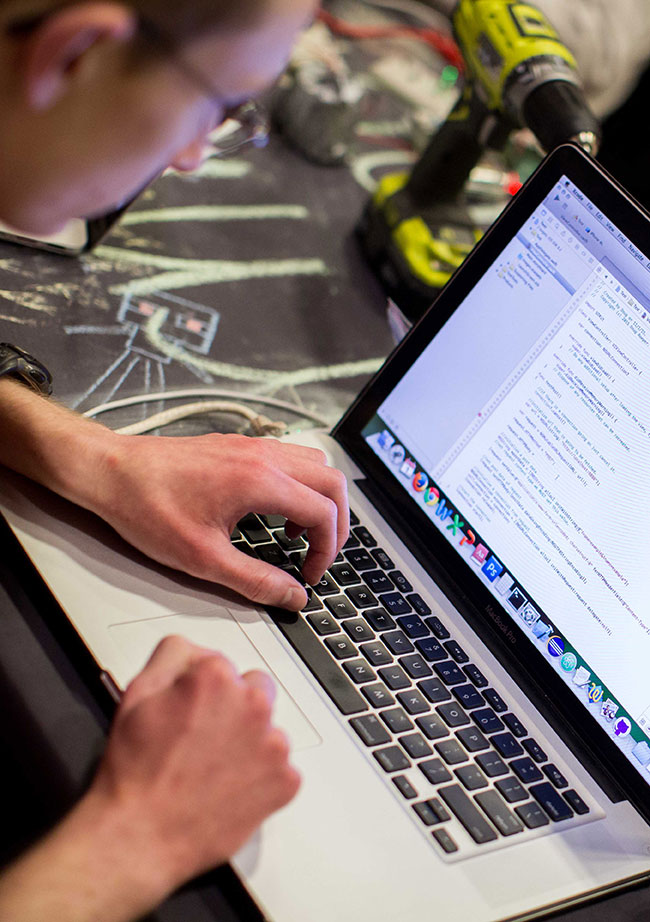Math and Computer Science on the Move
Two CAS departments have a new home in the much-anticipated BU Center for Computing & Data Sciences
![]() When the visually striking, 345,000-square-foot BU Center for Computing & Data Sciences opens its doors, faculty and students from two CAS departments—mathematics and statistics, and computer science—will begin moving in. The carbon-neutral facility will also be home to the Rafik B. Hariri Institute for Computing and Computational Science & Engineering and serve as a space for the Faculty of Computing & Data Sciences to collaborate in the booming field of data science and analytics. “This is the science that’s going to change the way we behave, driving our behavior for the next 50 or 100 years,” BU President Robert A. Brown said in his 2018 announcement of the plans to build the center.
When the visually striking, 345,000-square-foot BU Center for Computing & Data Sciences opens its doors, faculty and students from two CAS departments—mathematics and statistics, and computer science—will begin moving in. The carbon-neutral facility will also be home to the Rafik B. Hariri Institute for Computing and Computational Science & Engineering and serve as a space for the Faculty of Computing & Data Sciences to collaborate in the booming field of data science and analytics. “This is the science that’s going to change the way we behave, driving our behavior for the next 50 or 100 years,” BU President Robert A. Brown said in his 2018 announcement of the plans to build the center.
The building was designed to foster cross-departmental conversation and work. Floors one and two feature classrooms and study areas, as well as BU CS BUILD, a student makerspace. The bottom floors will be the most public spaces in the building—“an extension of Comm Ave,” according to Azer Bestavros, associate provost for computing and data sciences and the William Fairfield Warren Distinguished Professor of Computer Science at CAS.
“This is the science that’s going to change the way we behave, driving our behavior for the next 50 or 100 years.”
“What I look forward to the most is the energy that will be in that building, by virtue of the students,” Bestavros says. “The bottom part of the building is like the boiler; it’s where the energy comes in and just pushes up. That’s, to me, going to be the most exciting piece.”
You can’t have computing and data sciences without mathematics and computer science, Bestavros adds, which is why the departments will occupy the next section of the tower.
The Department of Mathematics & Statistics will be primarily on floors 3, 4, and 5 while administrative staff for both math and computer science will share the sixth floor. This arrangement reflects the foundational role of mathematics in the computing and data sciences, department chair Glenn Stevens says. “These foundations must be strong and uplifting,” he adds, “and we look forward to playing those roles, both literally and figuratively.”

Stevens says the center will further the development of core mathematics disciplines like algebra and number theory and will expand on emerging fields like computational arithmetic geometry, algebraic and differential geometry, and mathematical physics “in state-of-the-art classrooms with students and in generous collaborative spaces specially designed to encourage interactions among research colleagues working across the spectrum of the mathematical, computing, and data sciences.” He adds that the new facilities will support the department’s interdisciplinary teams working at the intersection of math and dynamical systems, biology, neuroscience, network analytics, finance, environmental science, and other fields.
The Department of Computer Science will occupy floors 6 through 10, in addition to part of the basement data center. With undergraduate computer science majors now exceeding 1,300—a 400 percent increase over a decade ago—chair Abraham Matta says the “world-class” center will give his department additional space for teaching, research, outreach, and community building.
“I am most looking forward to having our teaching labs and community building spaces colocated with faculty and staff offices, so we have more direct contact with our students,” Matta says. “I am also very excited about bumping into colleagues from mathematics and statistics and computing and data sciences and leveraging our shared spaces for fruitful and exciting collaborations.”